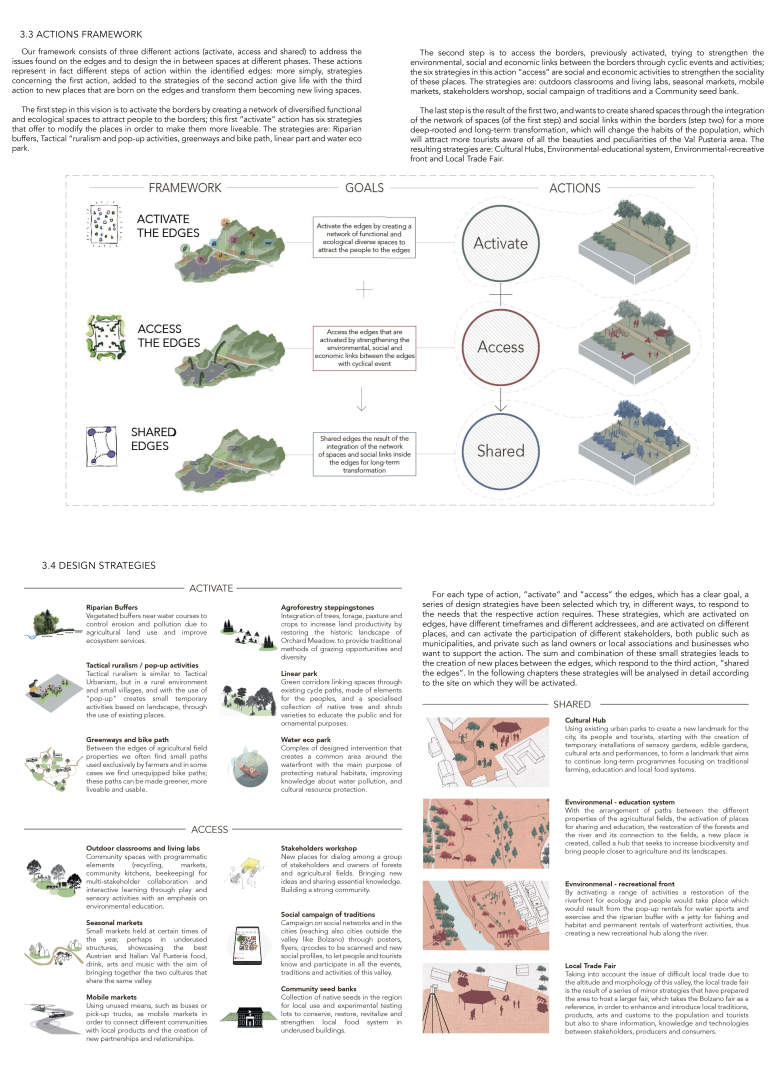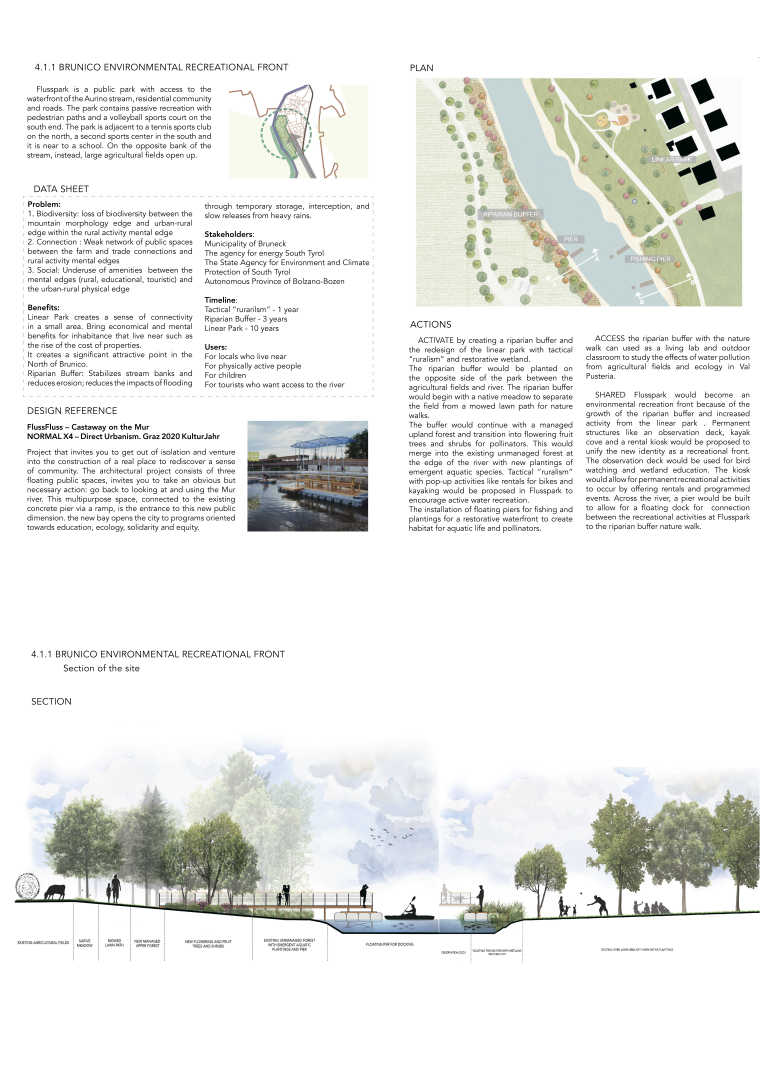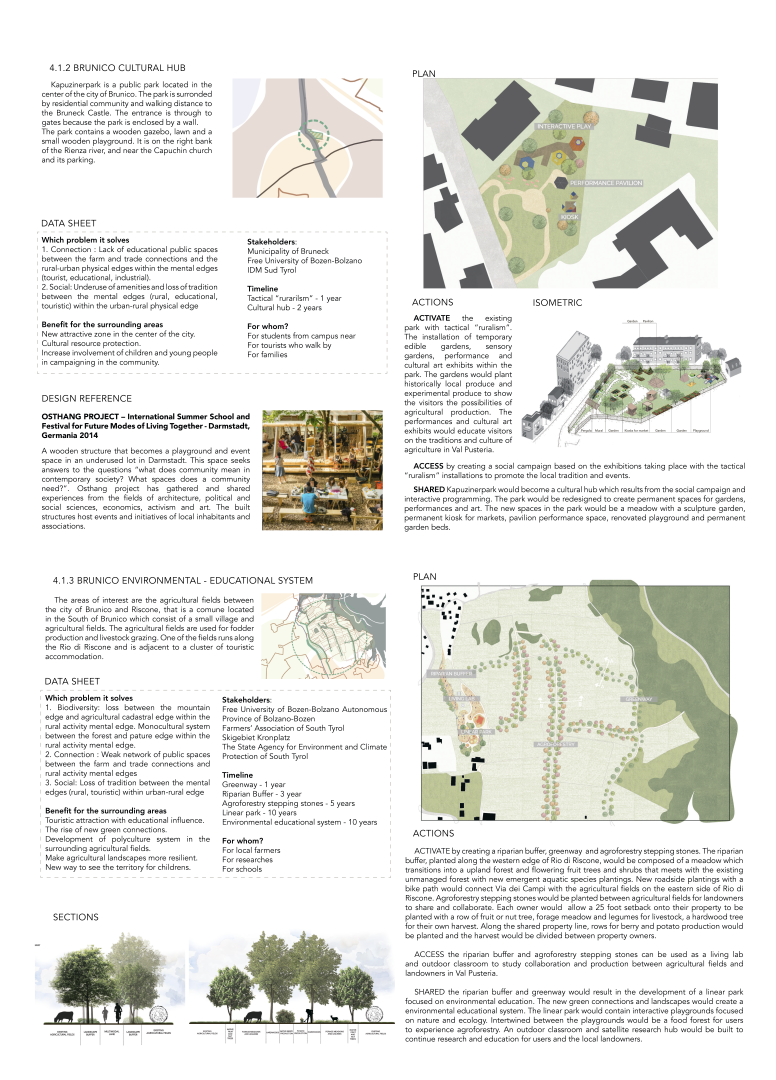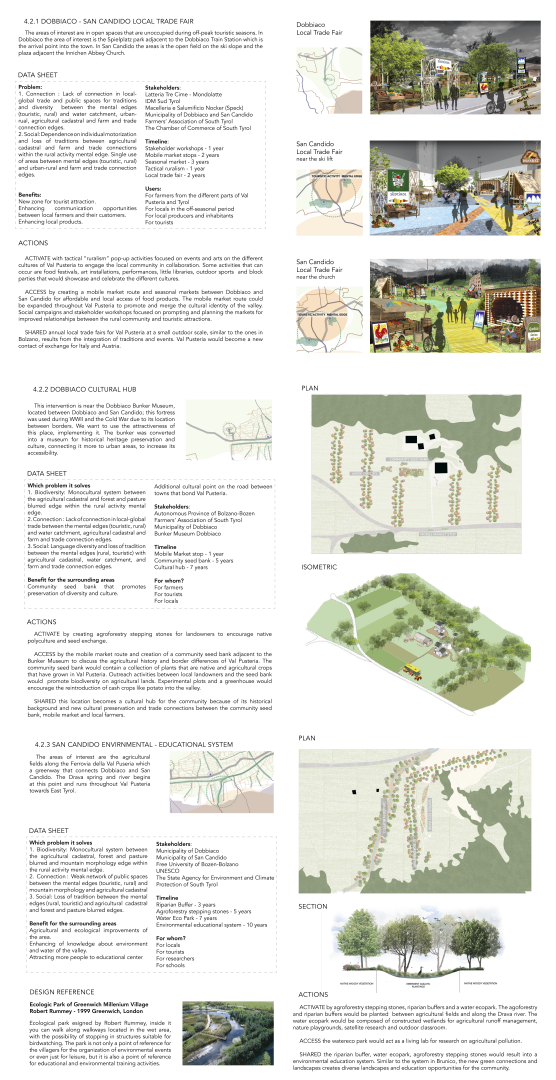Val Pusteria - Redefining the Edges
Basic information
Project Title
Full project title
Category
Project Description
We suggest to redefined space in-between physical and mental edges characterize the landscape of Val Pusteria and uncover the issues caused by the intense agriculture, economic growth and globalization. Concept of Edges, as a method of analysis, shows an opportunity to address and re-imagine these areas in tension to reduce inequalities, to develop a network of sustainable and resilient cities and rural areas by emphasizing the peculiarities and local identity of physical and social boundaries.
Geographical Scope
Project Region
Urban or rural issues
Physical or other transformations
EU Programme or fund
Which funds
Description of the project
Summary
“Agriculture today designs the city, what does this mean? in the sense that the definition of agricultural space involves an area that is now urban and every change that affect its (changes in irrigation techniques, cultivation or production of biodiversity, affects the condition of extended urbanity that we are used to calling the city” - Paola Vigano
So, does the countryside engulfs the city or the city engulfs the countryside? Mountainous landscapes, like Val Pusteria, are characterized by a relationship of integration between built areas and cultivated land which translates into a rarefaction of the built area, with a similar effect of the land use preservation. Therefore, area can be defined using this process of integration and refinement between rural and urban spaces. Environmental impacts and agricultural use there are directly related to the economic structure and tourism in the region. The valley landscape has shifted to meet the economic demands of the globalization of the Sud Tyrolean image. Physical and mental edges characterize the landscape and uncover the issues caused by the intense agriculture, economic growth, and globalization.
Concept of Edges provides a vision for the Val Pusteria future development area by working on the boundaries identified. The aim is to reduce inequalities at the territorial level to develop a network of sustainable and resilient cities in the valley that acts a bridge between the main cities and rural areas. Thinking about the development and involvement of local, predominantly agricultural cities, emphasizing the peculiarities and local identity of the area bringing benefits across physical and social boundaries. By working on the edges as an “in-between space” considered not as a line but as an area in tension between two different physical states with the influence of mental ones, where you find dynamism, innovation and energy, a resource where inertia fails, an opportunity and strength by using specific strategies.
Key objectives for sustainability
Between natural, rural and urban areas loss or changes in biodiversity occur. The monocultural system is emphasized throughout the cadastral boundaries of the
agricultural fields and is due to the demand for economic growth that has transformed the region from traditional polyculture to a monocultural system. The advancements of forests due to the lack of maintenance leads to the colonization of pastures and a blurred edge between forest and pasture edges. Between urban and rural edges there is a lack of green transition and buffers from fields to asphalt. All these relationships between these edges leads to low biodiversity in Val Pusteria.
By activate - access- shared actions (agroforestry stepping stones, riparian buffers, the water-eco park, linear park, environmental recreation front) in our pilot territories – Brunico, Dobbiaco and San-Candido (small cities in the Fondovalley) and the space between it - we suppose to:
- increase of biodiversity between the mountain morphology edge and urban-rural edge within the rural activity mental edge,
- diversify monocultural system between the forest and pasture edge within the
rural activity mental edge,
- diversify monocultural system between the agricultural cadastral and forest and pasture blurred edge within the rural activity mental edge,
- diversify monocultural system between the agricultural cadastral, forest and pasture
blurred and mountain morphology edge within the rural activity mental edge,
- reestablish biodiversity on the territory to maintain circular economy of the region.
Key objectives for aesthetics and quality
Aesthetic and quality of experience in our concept can be observed through the working with the connectivity issues. Observing the weak network of public spaces and connections within the urban cadastral and the rural context we suggest to involve practices of tactical ruralism to improve the visual perception of the public spaces as well as create new points of interactions to develop social-spatial relationships. Through the working with a lack of connection between the local and global trade, which arose because of the historic difficulties the mountain terrain presented limiting trade to the city of Bolzano, and dependence on individual motorization, which can be seen between the mountain and valley edges which only allowed for the construction and use of one major road, we introduce the option of local trade fairs and mobile markets to diversify the functionality of the area and increase the opportunities for local communities. Moreover, through the increasing the biodiversity of the territory we expect to change the mental perception of the natural elements and agricultural land.
Key objectives for inclusion
Social issues emerge in the identity of Val Pusteria because of its historical political past between Austrian and Italian border changes. The water catchment is both a physical and
mental edge which separates the Italian and Austrian water systems.
The single or underuse of local amenities is an issue that occurs within the-physical edges, when schools are left unused during the summers.
This issue also occurs along the mental edge between the tourist and the rural activities, when the ski season is low, the local economy does not benefit, and the area is underutilized.
The tradition of Val Pusteria is influenced and being lost because of the marketing perception for tourism and economic growth which misrepresents the real peculiarities of the territory.
The goal of Edges concept is to emphasis the peculiarities and local identity of the boundaries and reduce the inequalities at a territorial level to develop a network of sustainable and resilient cities and rural areas. By activate - access- shared actions (environmental recreation front, tactical “ruralism”, cultural hub, linear park focused on environmental education, mobile market route, local trade fairs) in our pilot territories – Brunico, Dobbiaco and San-Candido (small cities in the Fondovalley) and the space between it - we suppose to:
- reestablish the loss of tradition between the mental edges (rural, touristic) and agricultural cadastral and forest and pasture blurred edges,
- activate the use of amenities between the mental edges (rural, educational, touristic) and the urban-rural physical edge,
- decrease dependence on individual motorization and loss of traditions between agricultural cadastral and farm and trade connections within the rural activity mental edge,
- diversify using of areas between mental edges (touristic, rural) and urban-rural and farm and trade connection edges,
- support language diversity and build the connection between them.
Physical or other transformations
Innovative character
Our framework consists of three different actions (activate, access and shared) to address the issues found on the edges and to design the in between spaces at different phases. These actions represent in fact different steps of action within the identified edges: more simply, strategies concerning the first action, added to the strategies of the second action give life with the third action to new places that are born on the edges and transform them becoming new living spaces.
The first step in this vision is to activate the borders by creating a network of diversified functional and ecological spaces to make territory more accessible and attract people to the borders; this first “activate” action has six strategies that offer to modify the places to make them more liveable. The strategies are: Riparian buffers, Tactical “ruralism and pop-up activities, greenways and bike path, linear part and water eco park.
The second step is to access the borders, previously activated, trying to strengthen the environmental, social and economic links between the borders through cyclic events and activities; the six strategies in this action “access” are social and economic activities to strengthen the sociality of these places. The strategies are: outdoors classrooms and living labs, seasonal markets, mobile markets, stakeholders workshop, social campaign of traditions and a Community seed bank.
The last step is the result of the first two, and wants to create shared spaces through the integration of the network of spaces (of the first step) and social links within the borders (step two) for a more deep-rooted and long-term transformation, which will change the habits of the population, which will attract more tourists aware of all the beauties and peculiarities of the Val Pusteria area. The resulting strategies are: Cultural Hubs, Environmental-educational system, Environmental-recreative front and Local Trade Fair.






